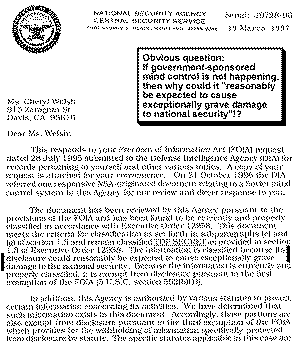|

September 28, 2000
from
Raven1 Website
recovered trough
WayBackMachine Website
DEMONSTRATION PROCEDURES
1. THOROUGHLY go through the
setup procedures first. You need to be completely familiar with
the unit before attempting to demonstrate it to the public. Be
sure your battery has been charged overnight.
2. Shortly before the demo, refresh yourself on:
3. MATERIALS
You need, when dealing with the public:
-
a printout of THIS SET OF
INSTRUCTIONS
-
a printout of hypno2s:
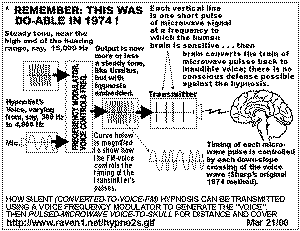
-
a printout of cover:

-
a picket sign (if outdoors without a
pre-arranged meeting with visitors)
-
some handouts, one sheet of which
MUST be (This has proven very compelling to those who
read it):
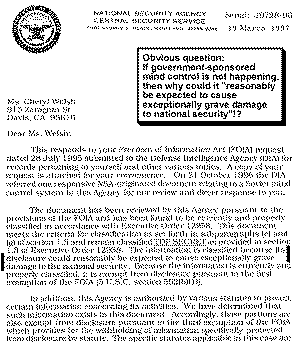
-
for YOUR reference, a printout of
Judy Wall’s article on
silent sound, including Gulf War use
-
a copy of these instructions and
spiel script
-
small flip-nozzle container of water
for your voice and perhaps throat lozenges
-
sunscreen and sun hat if outdoors
-
a small tape recorder with a
voice-ONLY cassette, normal sound
-
a patch cord between the “ear” jack
on the recorder and the MONO 1/8” jack on the demo unit (keep
volume low or use an attenuator from Radio Shack. Excess volume
results in garble.)
Some may find this image explaining
silent sound WITHOUT the extra clutter from the voice-to-skull
attachment easier to use:
-
a printout:
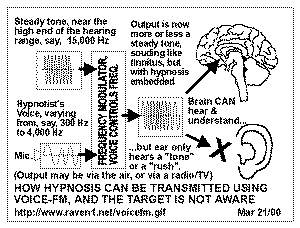
Some may wish to hand out schematics. I
recommend this schematic and matching solder-side component
placement image:
-
schematic:
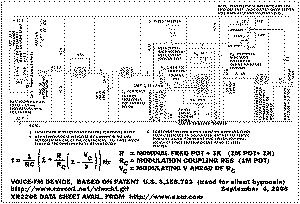
-
solder-side layout:
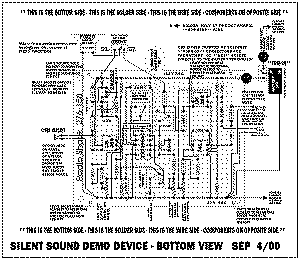
4. ICE-BREAKER. Mine is a picket sign that carries this message:
“GOVT-MEDIA TELL THE PUBLIC ABOUT ELECTRONIC MIND WEAPONS”:

5. SPIEL.
The words below VARY according to the person I’m talking
with, and for best effectiveness you will need to judge just how
interested the visitor is.
I’ve had SHORT visits like:
VISITOR: What is this? (Pointing to
the demo unit)
DEMONSTRATOR: This is a device which takes ordinary human
speaking voice and does two things to it:
-
converts it from natural AM
(amplitude modulation) to FM (frequency modulation); this
garbles the voice
-
raises the average frequency from
around 1,500 Hertz, which is normal, to around 15,000 Hertz.
At 15,000 Hertz, young people with good
hearing can hear a slight “ringing in the ears” from this device,
while many adults hear nothing at all.
But the brain CAN HEAR THE WORDS, even though the ear cannot.
This allows a hypnotist to program an individual over months and
years without the target being aware. There is no resistance to the
hypnosis because the target doesn’t hear it.
This can be beneficial, but it can also do severe damage to a
person’s well being. This is why our group is out here
demonstrating.
We want government to earn their salaries and perks by placing
controls on who can possess such devices and what can be legally
done with them.
VISITOR: Thank you (and leaves.)
LONG visits start out as above. If questions keep coming, you
will need to answer them. Below are some typical questions and
answers:
DEMONSTRATOR: (Continuing from the “short” spiel above)
** AT THIS POINT, YOU MAY WANT TO DROP DOWN THIS SCRIPT TO ITEM #6
far below,
THE ACTUAL PHYSICAL DEMO OF THE UNIT. I HAVE FOUND THAT A GREAT MANY
VISITORS DO NOT WANT TO HEAR THE UNIT. I NEVER PRESS THAT ISSUE WITH
THEM, AND ONLY START IT UP WHEN ASKED.
This device as it is here is harmless, unless used on someone who
has already been programmed with trigger words or phrases. It
becomes very invasive and dangerous, though, if connected to a
voice-to-skull projector. A voice-to-skull projector is a modified
radar transmitter in which the human voice controls how close
together the radar pulses occur.
In 1974, Dr. Joseph Sharp, of the
Walter Reed Army Institute of
research, announced his successful transmission of speech directly
into the human skull with no receiving device. By connecting this
“silent sound” device to a voice-to-skull transmitter, it is
possible to transmit hypnotic phrases silently into a target’s
bedroom, every night, for years, without the target’s being aware.
By programming enough “Pavlovian triggers” into an individual, that
individual’s personality can be changed substantially.
Using pre-programmed trigger phrases, a “handler” of that individual
can literally use him or her as a “living robot”, in cases where the
individual has high susceptibility to hypnosis.
The process of programming enough triggers into an individual for
purposes of control is called “creating a Manchurian Candidate”,
after two books of that title.
The formal program of the CIA, begun in the 1950s, started out as
149 separate experiments, and was in response to cold war fears and
the apparent “brainwashing” of Allied POWs in Korea. This group of
“behaviour modification” experiments bore the code name MKULTRA.
MKULTRA did include electronic mind control devices, but the best
known electronic mind control device of the early days was the
Russian
LIDA machine. The LIDA, one of which is in possession of
Veterans’ Administration researcher Dr. Ross Adey, “entrained” or
electronically coerced a target in the path of it’s signal to be
relaxed and more susceptible to hypnosis. A few Korean War vets
claimed to have seen the LIDA in use at the POW camps.
The MKULTRA code name ceased in the late 1970s when the
U.S.
Senate’s Frank Church Committee investigated MKULTRA experiments and
found that serious atrocities had been committed on people in the
military, prisons, or in mental hospitals. However, not one single
perpetrator from the MKULTRA programs was ever brought up on
charges.
We know that electronic mind
control experimentation did not cease, and this “silent
sound” technology was used in actual military combat in the
1991 Gulf War. The United States Army connected a silent
sound voice converter like this one to an FM broadcast
transmitter, broadcasting on a frequency of 100 Megahertz,
and the silent hypnotic commands were carried right on top
of normal voice in the Iraqi language. The normal voice
carried confusing information, while the SILENT component
reinforced a sense of
despair by hypnotic suggestion.
This was documented on Britain’s ITV network, but not shown in the
U.S. or Canada.
The successful use by the U.S. Army clearly shows that this
technology does work. Through-the-wall voice-to-skull technology
makes it almost inescapable. Our group hopes that eventually the
public will learn enough about the invasive privacy destroying
electronic mind control weapons available today to demand that
government report on these devices to the people, and make their use
and possession matters of ongoing PUBLIC record.
Electronic mind control devices have been under development for 50
years, and our group knows only the unclassified and commercial
versions.
The time for public input and control of all such
technologies is LONG overdue.
6. ACTUAL DEMONSTRATION OF
THE UNIT ITSELF
Put a tape with VOICE (not music) into your demo tape recorder.
Connect a patch cable between the “ear” jack on the recorder and the
INPUT jack on the demo unit. If you have an attenuator, use it, but
if not, remember to keep the volume setting on the recorder quite
low. Excess volume garbles the speech making for an un-convincing
demo.
Switch on the demo unit. Adjust the tone near the lower end of the
frequency knob’s travel. The Input Level should be around one third
of it’s way up from it’s lowest position.
Push PLAY on the recorder. You should hear speech “mixed” in with
the demo unit’s tone. This demonstrates to a visitor what simply
converting natural human voice, which is AM or amplitude modulation
to FM or frequency modulation sounds like. Near the low end of the
frequency knob’s travel, the frequencies of the voice are still
about at their natural values, but the mode is now FM, as opposed to
AM. THE VISITOR CAN HEAR THIS IS GARBLED.
Now slowly increase the frequency knob until the audible sound is as
HIGH as you and your visitor can just hear. If you are both adults,
this point is approximately where the brain can start to convert
this inaudible sound BACK TO WORDS. The process is called “slope
tuning”. You can move the IN-OFF-OUT switch back to IN to show the
visitor that voice is actually being fed into the unit.
Below image, shows how the brain recovers the inaudible words using
the process of “slope detection” or “slope tuning” - worth having a
few of these for technical folks who are interested in how it works.
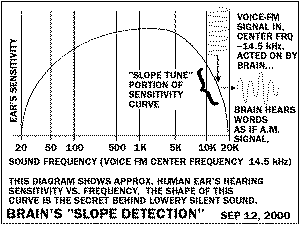
If you have a frequency counter or meter, connect it to the two
binding posts, one red, one black, on the front panel. During a demo
adjust frequency somewhere between 14.5 and 14.8 kHz (14,500 Hertz
to 14,800 Hertz.)
This is the range where both
the Lowery patent
(5,159,703) and the New Zealand Altered States company operate at to
produce brain-understandable silent sound.
SEE ITEM 4 BELOW UNDER SETUP FOR COMMENTS ABOUT USING AN AUDIO
LEVEL METER TO ENHANCE YOUR DEMONSTRATION
SETUP PROCEDURES
Below image, shows what the scope trace should look like when proper
frequency modulation by voice is applied.
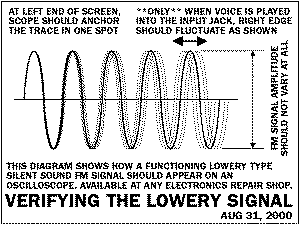
Below image, shows how the brain recovers the inaudible words using
the process of “slope detection” or “slope tuning” - worth having a
few of these for technical folks who are interested in how it works.

-
You will need a small voltmeter to
monitor battery charge state.
This must be a small meter that reads out VOLTS, and NOT a
“battery OK” meter with red and green scales. It is necessary to
know voltages for communications by email or phone with people
who can offer technical help.
A convenient meter is the Radio Shack 22-802, for around $30,
which has a folding case fully containing the two probes and
their cable. The only trick with any meter is TO REMEMBER TO
SHUT IT OFF WHEN YOU ARE FINISHED. Almost all of today’s
voltmeters have digital displays and have their own small
internal battery. (Pick up and carry a spare battery.)
-
First job is to charge the internal
12-volt gel cell.
The charger supplied with units purchased from Eleanor White is
a simple “wall mount” style 12-volt power supply, with a cable
that cannot be connected with the wrong polarity.
Measure the voltage by touching the positive (red lead) screw on
the terminal strip with the red probe, and the negative (black
lead) screw on the terminal strip with the black probe.
You should get “13 something” volts if the battery is reasonably
well charged. If you get zero volts, it is likely that one of
the ¾ amp fuses is blown. Check both fuses to be sure.
You can check a fuse visually, but ¾ amp size is hard to see.
Instead, switch your meter to K-ohms and put the probes on
either end of the glass fuse. The fuse should show zero or very
close to zero if it is good. The fuses are 5 MILLIMETER and you
may need to go to Radio Shack to get replacements.
!!!!! SWITCH YOUR METER OFF
or BACK TO VOLTS WHEN FINISHED !!!!!
Now remove the probes and connect your charger. Put the probes
back on their screws and note the voltage reading. If charging
is in progress, you should see “14 something” volts and perhaps
as high as 15 volts. If you don’t, something is wrong - see the
paragraph on blown fuses above, or be sure the charger is
plugged in, or be sure the outlet has power.
If your “wall mount” power supply has a SLIDE SWITCH TO CHANGE
VOLTAGE, be sure it is set to “12”.
-
Switch the unit on. You should see
the LED on the panel lit up.
If not, check the fuses.
Switch the IN-OFF-OUT switch to OUT. Turn the frequency control
to the lower part of its travel. Be sure the Output Level knob
is at least ¼ of the way up. You should hear a steady tone.
Test that the frequency control can raise the tone high enough
that you can no longer hear it, then bring it back down low.
Switch the IN-OFF-OUT switch to IN. Raise the Input Level to
full scale. If you get a squeal, as sometimes happens with PA
systems, you need to make a mental note of where that occurs and
not go above that point with INPUT level.
-
Put a tape with VOICE (not music)
into your demo tape recorder.
Connect a patch cable between the “ear” jack on the recorder and the
INPUT jack on the demo unit. If you have an attenuator, use it, but
if not, remember to keep the volume setting on the recorder quite
low. Excess volume garbles the speech making for an un-convincing
demo.
Switch on the demo unit. Adjust the tone near the lower end of the
frequency knob’s travel. The Input Level should be around one third
of it’s way up from it’s lowest position.
Push PLAY on the recorder. You should hear speech “mixed” in with
the demo unit’s tone. This demonstrates to a visitor what simply
converting natural human voice, which is AM or amplitude modulation
to FM or frequency modulation sounds like. Near the low end of the
frequency knob’s travel, the frequencies of the voice are still
about at their natural values, but the mode is now FM, as opposed to
AM. The visitor can hear this is garbled.
Now slowly increase the frequency knob until the audible sound is as
HIGH as you and your visitor can just barely hear. If you are
both adults, this point is approximately where the brain can start
to convert this inaudible sound BACK TO WORDS. The process is called
“slope tuning”. You can move the IN-OFF-OUT switch back to IN to
show the visitor that voice is actually being fed into the unit.
If you have a frequency counter or meter, connect it to the two
binding posts, one red, one black, on the front panel. During a demo
adjust frequency somewhere between 14.5 and 14.8 kHz (14,500 Hertz
to 14,800 Hertz.) This is the range where both the Lowery patent
(5,159,703) and the New Zealand Altered States company operate at to
produce brain-understandable silent sound.
If you have an AUDIO LEVEL METER, it can be used to show that sound
is coming out at 14.5 kHz even though it is inaudible.
!!!!! BUT BEWARE !!!!...
Some audio meters like Radio Shack’s CUT OFF AT OR NEAR 20 kHz.
You need to do considerable testing in private before you attempt
audio meter proof in front of visitors. It is quite easy to get the
frequency too high, in which case the audio level meter will show
nothing at all.
To be practical, you really would need a frequency meter connected
to the binding posts to assure yourself you were in the 14.5-14.8
range.
Furthermore, the piezo-tweeter is good at high end frequencies, but
the common audio chips in the unit are not really strong at these
high-end frequencies. If you plan to use an audio level meter, I’d
recommend something like the Radio Shack amplified speaker,
catalogue #21-541, requiring it’s own separate 12-volt source (the
demo unit’s can be tapped by someone with electronic assembly
skills. This will shorten the charge life of the demo unit’s battery
but may be worth doing anyway.)
If you do use an external amplifier, be SURE it gets it’s normal
voice coil speaker replaced with a PIEZO unit or the high frequency
sound won’t get through well enough for the audio level meter to
detect.
|

